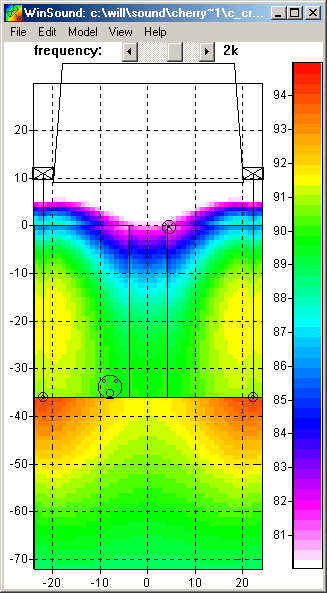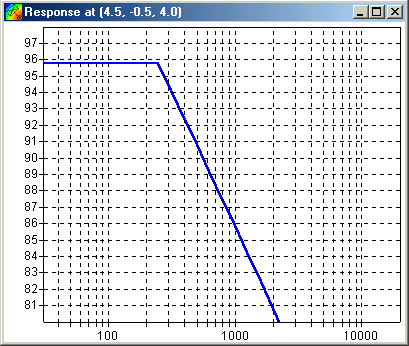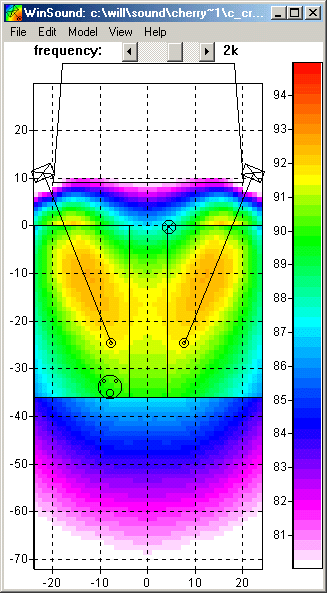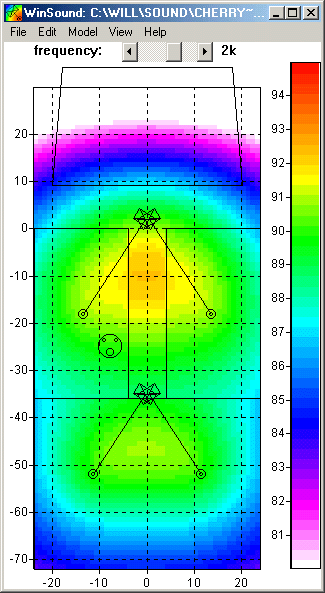
Download the model of the current setup: c_creek1.wsd.
Listeners in the rear and balcony seats have complained
that they have a hard time understanding what is said, even though volume
levels seem high enough. This analysis concludes that the speakers
are positioned to allow too much direct sound to stray from the audience
and excite the highly reverberant room. A new, unique arrangement
is proposed in which two two-speaker clusters supply sound to the main
floor and balcony, respectively.
description
Cherry Creek Community Church is a long, tall room measuring roughly 50W x 100L x 40H. That's right--the ceiling is forty feet high. It would be a rectangular box except for the walls' geometry: a corrugation about 9 feet long causes the wall to protrude inward and outward by about 2 feet. This is a nice feature because it prevents standings waves.
And the acoustics confirm this. While the reverb time is long (ear-ball RT60 is about 3 seconds), it is a pleasant, smooth reverb. However, it is hard to hear unaided speech from more than 20 feet from the talker.
The room has a balcony which extends about 35 feet backward and slopes upward placing the listeners' ears on a plane that begins at 14 feet in front and ends at 25 feet in back. In addition, more seats exist under the balcony with a low ceiling that shadows the speakers.
The main speakers (Yorkville Elite E358's with a 60x40 polar pattern) are hidden in "cages" that protrude from the walls at the front of the stage--about 10 feet from the front row. Their horns are about 15 feet above the floor.
method
The method here investigates the speaker-sound man-audience system using the WinSound program. In short, direct sound is computed for the sound operator and equalized to provide flat response ('cause that's sort of what he does). Then it is computed for every seat in the house. The computations account for 3D position and orientation of the speakers as well as their polar characteristics. While absorption, reflection, and reverberation are not directly calculated, they are addressed by a strategy which seeks to confine the direct sound to the audience. Since the audience is highly absorptive, the reverberant field will be excited less reducing its level and improving intelligibility.
results
The following shows the map for 2000 Hz--a good frequency for intelligibility:

Download the model of the current setup: c_creek1.wsd.
Notice the following:
The analyzer shown above (in the front row) has the
following response:

This is both too loud at low frequencies (relative to the sound operator at 90 dB) and terribly "muddy" (-15dB at 2kHz where the directivity is approximated). The muddiness comes from the speakers focusing the high frequencies over the heads of the front row, but omnidirectional low frequencies reach them just fine.
A temporary solution is to re-aim the speakers into the main audience as shown below (the aim points are at ear level):

This will take energy away from reflections and reverberation and invest it into the audience without any of the complexity of flying hardware and labor. However, levels to the balcony will be significantly lower possibly rendering the balcony unusable. But most main-floor seats should be noticeably improved. Phase interaction will increase between the speakers, and this degrades sound somewhat. But the benefit of better direct levels and less excitation of the reverberant field outweigh these concerns in this case. Still, it is recommended as a temporary solution.
The long-term recommended solution is a dual-cluster design. The following shows this system at 2000 Hz:

Download the model of the recommended setup: c_creek2.wsd
It has the following attributes:
conclusions
Substantial improvement in intelligibility and overall quality can be achieved for most listeners by replacing the two existing speakers with four flown speakers and without absorption treatment.